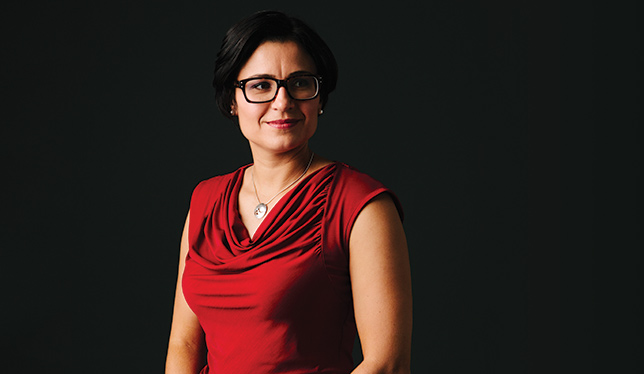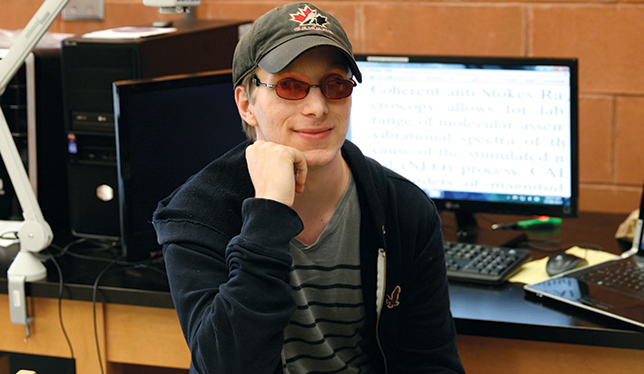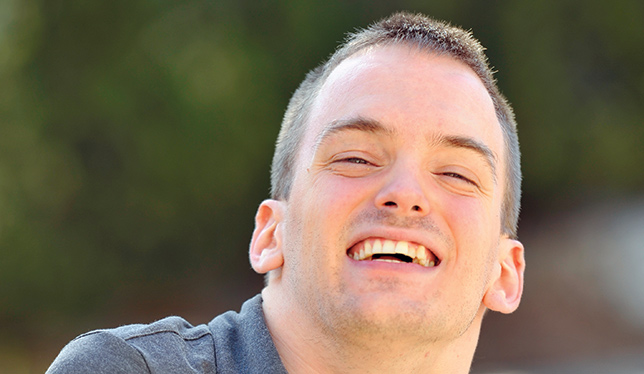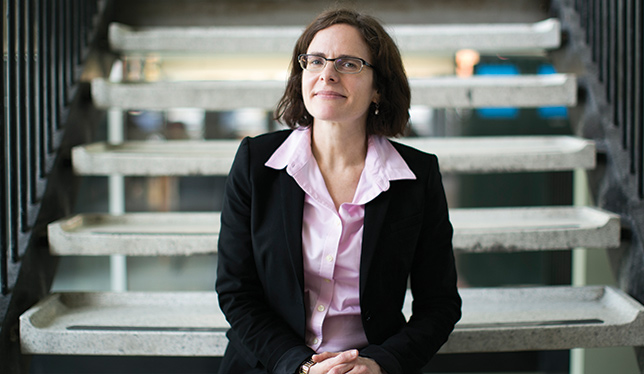Evolving attitudes, policies and technology have given rise to a generation of undergrads, graduate students and faculty members with disabilities who demand inclusive spaces, teaching styles and supports.
“More and more students with different disabilities who didn’t previously access postsecondary education are beginning to do so,” says Stewart Engelberg, director of Trent University’s Student Wellness Centre. Universities don’t always have accommodations in place when a student with a particular disability arrives, Mr. Engelberg explains, but “it’s important to invest the time to develop appropriate systems.”
Although the fact that it’s the right thing to do should be reason enough, sometimes decision makers need more convincing. It may be necessary to remind administrators of their legal duty to accommodate, as well as the practical benefit: there’s a long-term payoff since accommodations and services will certainly be used by others to come.
Four scholars who are breaking ground in their respective fields reflect on their triumphs and struggles to show how far academia has come in attracting students and staff with disabilities. Their stories also reveal how much further Canada’s universities still need to travel.

Jessica Dunkley, medical resident, University of Alberta
Growing up deaf from birth, Jessica Dunkley didn’t imagine going to university, let alone medical school. University had been out of the question for her deaf Métis parents and many of her mentors in the deaf community. But she fought hard – first getting into a physiotherapy program and then realizing, through exposure to the hospital setting, that she wanted to be a doctor and that new technology like a visual stethoscope made it possible. She excelled through medical school.
Then, in the first year of her residency program at the University of British Columbia, she felt that neither the university nor the local health authority was able to provide her with the interpreters she believed she needed to fulfill her hospital requirements. UBC supported Dr. Dunkley’s goal of becoming a practising doctor, and “regrets that we were unable for financial reasons to provide the accommodation that Dr. Dunkley sought,” says Brian Kladko, spokesman for the UBC faculty of medicine. (Her complaint to the B.C. Human Rights Tribunal will determine whether the university and health authority met their obligations to Dr. Dunkley.)
Melanie Lewis, associate dean of learner advocacy and wellness at the University of Alberta’s medical school, was approached by Dr. Dunkley when she started the residency application process for a second time. Dr. Lewis encouraged her to apply to the school’s residency program.
“Her perseverance is an amazing quality that transfers well into a health-care career,” says Dr. Lewis. But coordinating interpreters to cover Dr. Dunkley’s grueling 24-hour on-call shifts wasn’t easy; nor was convincing health officials to allow interpreters on her rounds. (Dr. Dunkley also speaks fluently and lip reads.)
Dr. Lewis recalls that at least a dozen meetings were held to allay concerns and hash out logistics. She says the hospital didn’t have sign language translators, which she found disheartening, given that translators were available for various spoken languages. But having Dr. Dunkley and allies at the meetings helped immensely.
“Everybody creates issues that were never issues, so if you can bring the individual to the table you take away the hypotheticals,” Dr. Lewis explains. She adds that such hypotheticals are now resolved for future deaf residents. “Now there’s clear recognition that the interpretation is in real time and it doesn’t cause delays in health care.”
As a resident, Dr. Dunkley still encounters challenges and feels the need to be “extra diligent” to prove herself. “Some people are quick to assume that if I missed something, it is because of my deafness,” she notes. “They don’t consider that I’m human.”
Tom Corbett, an obstetrician and gynecologist who supervised Dr. Dunkley during her obstetrics rounds, says her presence in any hospital will increase access for deaf patients, who aren’t always able to bring an interpreter and who, in the past, have written to him in notebooks. Due to Dr. Dunkley’s understanding of the barriers that marginalized patients face, she’s a rare combination. “Extremely intelligent as well as kind and compassionate,” says Dr. Corbett. “She will go very far.”

When Ryan Cole was applying for university, he intentionally didn’t mention in the application that he’s legally blind. “I hate being given stuff because I’m blind and not being given stuff because I’m blind,” he says.
Unsurprisingly, considering his 95 percent grade average, Mr. Cole was accepted to all the programs he’d applied to. When he called disability services offices to explain his circumstances, however, one person suggested that he attend another school better known for its disability supports, while another said it’d be up to him to figure out logistics like how to access lecture notes. So, when a cousin suggested Trent University’s science program, Mr. Cole called the disability services office. “They said, ‘We’ve never done this before but we’ll make it work.’”
Mr. Cole went on to win the Lodge Physics Scholarship as the top student in second and third year; he’s now started a master’s degree in materials science at Trent.
Making it work is Mr. Cole’s specialty. While still in school, it took him two years to get a computer with screen-reading technology. As Mr. Engelberg of Trent’s student accessibility services puts it: “A barrier is not really a barrier, it becomes a challenge for him.”
One of the first challenges Mr. Cole faced was when his just-translated braille textbook arrived in the form of 60 unwieldy volumes. Working with student accessibility services, Mr. Cole obtained the high-resolution digital version of the textbook and a projector, allowing him to magnify the pages on the wall. (Mr. Cole has some vision – what most people see as six metres away, he sees as around 120 metres away.)
Laboratory work posed another issue. While Mr. Cole’s lab partner did the experiments in his first year, his professor Al Slavin didn’t want Mr. Cole to miss out on the practical experience, and he suggested they both look for a solution. Mr. Cole found the answer: a digital camera that magnifies video up to 700 times onto a 43-centimetre monitor. When inserting a wire into a tiny plug, for example, Mr. Cole can now watch what his hands are doing on the monitor, says Dr. Slavin.
Trent has 12 students enrolled with visual impairments, including one – a computer science student with marks in the 90s – who has no vision at all. While Mr. Cole points out that most legally blind people are discouraged from pursuing the natural sciences, in fact visually impaired people develop skills that lend themselves well to physics and mathematics.
“There’s a lot of putting things together abstractly and visualization,” explains Mr. Cole, adding that blind people often mentally map out buildings and streets. Meanwhile, the “well-practised memory” of the visually impaired means they can easily memorize equations.
Aaron Slepkov – who holds the Canada Research Chair in the Physics of Biomaterials and heads the biophotonics lab where Mr. Cole has worked for the past two summers – finds it ironic that Mr. Cole struggles with tasks that are taken for granted by others but, unlike his classmates, develops mathematical models with ease. In Mr. Cole, says Dr. Slepkov, “you have the makings of a research superstar.”

Thanks to Taylor Oetelaar’s unique passion for history, architecture and computational fluid dynamics, we can now imagine what it would be like to lounge in a third-century Roman bath that was heated by multiple fires below a suspended floor. One of many findings of Dr. Oetelaar’s research, for instance, is that the air temperature would have been akin to a modern sauna, even in the winter. His digital reconstruction of the Baths of Caracalla is now part of a high-tech, 3-D model of ancient Rome called “Rome Reborn,” which is being exhibited in museums around the world. But his research applies to the present day, too. “Seeing how the Romans incorporated their systems might give modern engineers ideas for the next innovation,” says Dr. Oetelaar.
His PhD supervisor, engineering professor David Wood, says it’s not only Dr. Oetelaar’s “extraordinary intelligence” as an engineer that impresses him but also his “very strong knowledge about the architectural issues and societal issues.” (Dr. Oetelaar writes in his dissertation there were almost 900 baths in Rome, which he compares to the 102 Starbucks in Calgary.)
One of the first engineering students in a wheelchair at the University of Calgary, Dr. Oetelar’s cerebral palsy leaves him with the use of one arm, makes speaking difficult and means he can walk only very short distances. As an undergrad, he had automatic doors and accessible desks installed in all of his classrooms (which remain in place) and he was the impetus for a ramp into the mechanical engineering building. During the course-work portion of his doctoral program, he had a full-time aide and scribe to take notes. He later relied on his brother to help him with experiments involving an electrical heater – “to ensure that in case a catastrophe happened, someone would be there to help me,” he explains. He typed his entire dis-ser-tation with two fingers.
Dr. Oetelaar’s professors encouraged him to persevere. “I was extremely nervous about getting concepts across when I first began my teaching assistantship, but the professors assured me that I could do it,” writes Dr. Oetelaar, who delighted in teaching for the next four years. Since graduating with a PhD in mechanical engineering in 2013, he’s taken a position at a Calgary company that designs and builds high-tech telescopes.
Johanne Tottle, manager of student accessibility services at U of C, says the university takes an “individualized” approach to disability supports, meet-ing each student to discuss their needs as “equal partners in the process.”
“We don’t want to label people and provide supports based on a disa-bi–lity,” says Dr. Tottle. She says that people’s needs often change depending on the program, changing abilities and, chiefly, the students’ wishes. The key is not to let students think that accommodations are provided as a fixed package, she explains. “We tell our students that sometimes with accommodations, you do have to keep revising … we encourage them to keep coming back.”

The research of Kristin Snoddon, who began teaching at Carleton University in the fall, exposes a contradiction many Canadians are unaware of. Deaf individuals have the legal right to interpreters in educational settings, but learning sign language in the first place is becoming increasingly difficult.
Deaf children born to hearing parents often don’t have access to sign language programs in their crucial first years. In addition, cochlear implants – which can bring limited hearing to many deaf children – have led medical and educational professionals to view sign language as a barrier to spoken language development, says Dr. Snoddon.
She says this view of signing as a second-rate communication method undermines the “distinct linguistic and cultural identity of the deaf community.” The assault on sign language is also developmentally unsound – her research shows that models that encourage exposure to both sign and spoken language offer great developmental benefits for children.
Dr. Snoddon’s position as the first deaf professor at Carleton sends the message that “the deaf community needs to have a voice in the development of policies that affect them,” says Jim Cummins, Dr. Snoddon’s PhD supervisor and a professor at the Ontario Institute for Studies in Education at the University of Toronto. Carleton also employs several deaf sign-language instructors. In her teaching, Dr. Snoddon tackles current policies and practices around sign language and explores the various discourses around deafness.
Randall Gess, who directs the school of linguistics and language studies at Carleton, says Dr. Snoddon’s “enthusiastic, dynamic and engaging” teaching style will be attractive to many – he notes that this fall, the department is offering a minor in disability studies for the first time and that American Sign Language, or ASL, has surpassed Spanish as the school’s most popular language. (Though this hasn’t happened at most other Canadian universities, it does reflect a wider trend: ASL’s popularity at U.S. higher learning institutions grew by 16 percent from 2005 to 2009, according to the Modern Language Association.)
Carleton has hired a full-time interpreter, in addition to the part-time interpreters, who will help other hearing impaired ASL instructors to participate in university life, says Dr. Gess.
“Academia, in general, always benefits when there is support for diversity,” writes Dr. Snoddon. “Without this, there is a limitation on the ideas and knowledge promoted.”
Carleton is well known for its attendant program, which offers students with disabilities full-time aides to help with challenges that can stand in the way of learning. According to Larry McCloskey, director of the university’s Paul Menton Centre for Students with Disabilities, Carleton is now expanding this program to faculty members.